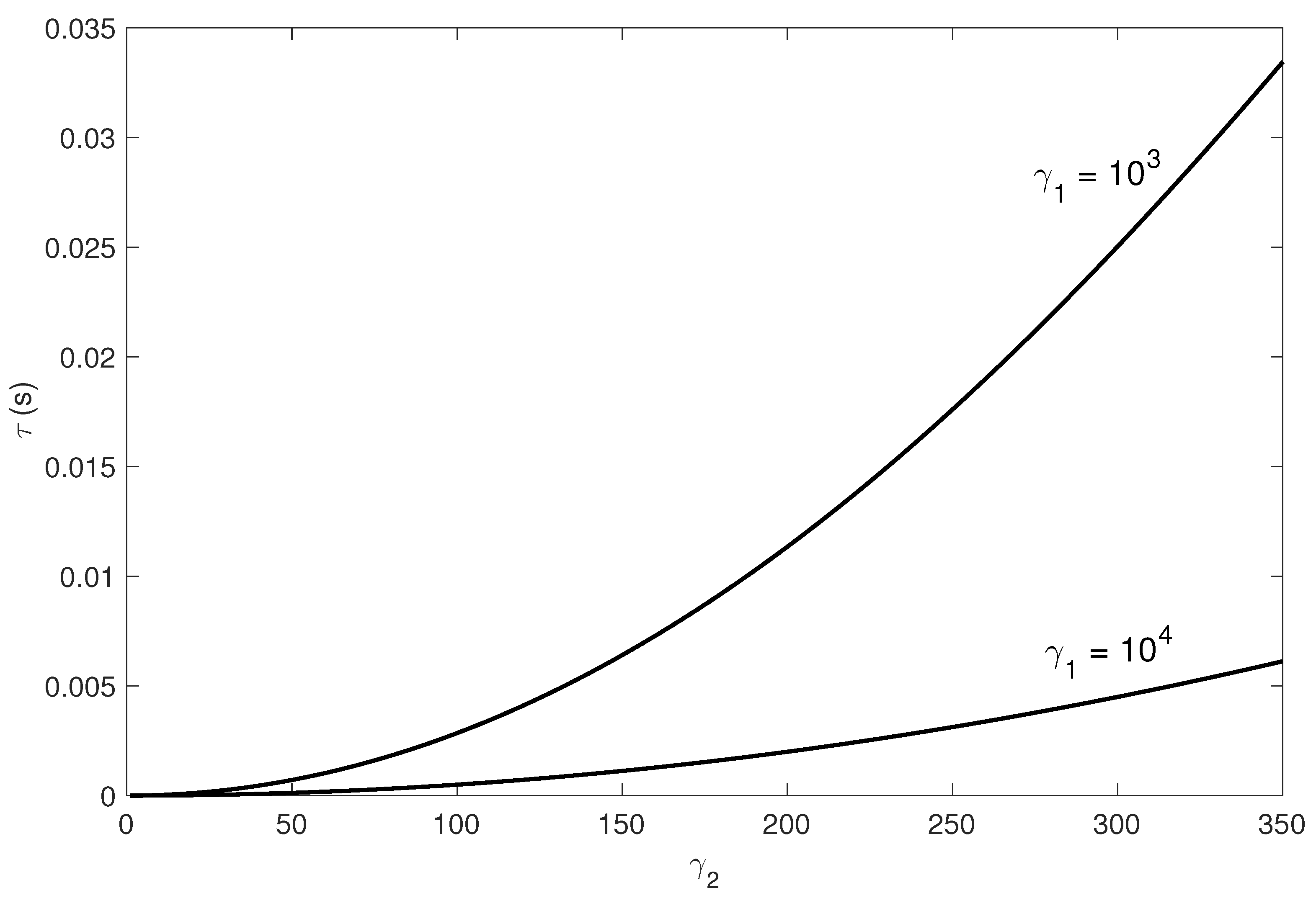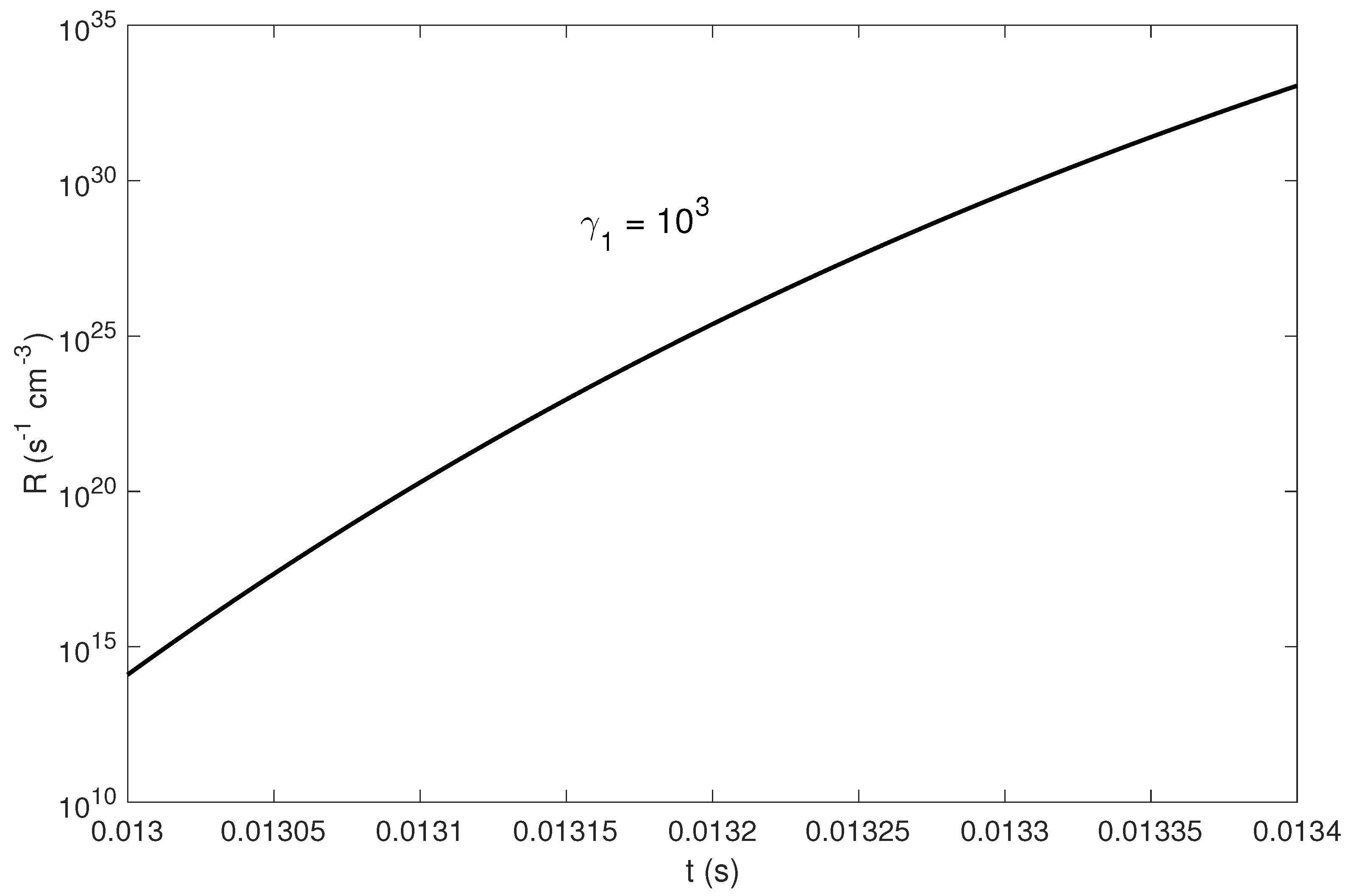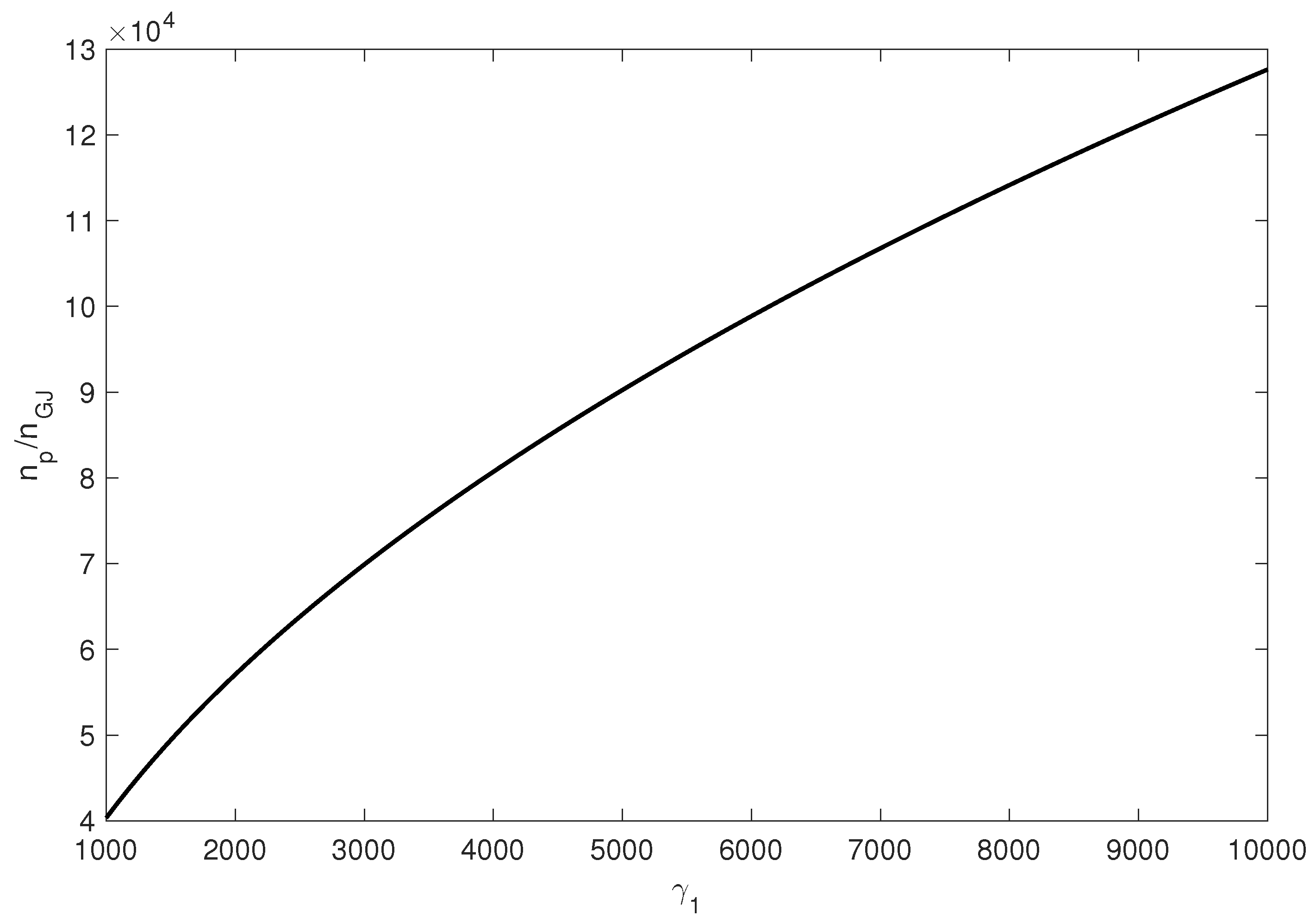1. Introduction
In 1969 Gold [
1] suggested that pulsars are rotating neutron stars that centrifugally energise a pulsar’s magnetospheric particles to energy values high enough to produce high energy electromagnetic radiation. Generally speaking, it is evident that neutron stars rotate with an increasing period of rotation,
P, characterized by the slow down rate,
. The corresponding slow down power
then becomes
where
is the angular velocity of rotation of the pulsar, the slow down rate is normalized by the parameters of the normal period pulsars (with periods of the order of one second),
is the moment of inertia of the neutron star,
and
cm denote its mass and radius, respectively, and
g is the solar mass. The value of
indicates that a pulsar is a reservoir of enormous energy, which potentially might lead to very interesting processes.
Gold’s idea provoked a new theory of pulsar electrodynamics proposed by [
2], where the authors described the spatial distribution of charges inside the light cylinder (LC) surface (a hypothetical area where the linear velocity of rotation coincides with the speed of light) and studied efficiency of acceleration of particles escaping the inner magnetospheric area on open magnetic field lines. As has been pointed out by [
3], the theory of [
2] could not explain an emission pattern of radio pulsars. To study this particular problem [
3] examined a general case: When the dipolar momentum of a neutron star is inclined with respect to the rotation axis. The main idea is based on the fact that, by means of interaction of very high energy curvature gamma rays and strong magnetic field of the order of
Gauss, the high efficiency pair production process initiates at the electron and proton polar zones. This model was extended by [
4], where apart from the pair production by means of the curvature photons, the author also studied the mechanism of hadronic photo-absorption. Several modifications of pair cascading were proposed in a series of papers [
5,
6,
7] considering the role of the strong magnetic field.
In general, strong electric fields can also contribute to the efficient pair cascading process. In particular, according to electrodynamics, in vacuum the virtual particles and antiparticles are continuously producing and annihilating. If, on the other hand, a strong electric field is present, it can separate the virtual charges significantly, leading, via quantum tunnelling, to pair creation. This happens when the work done on the Compton wave-length,
, equals the necessary energy of materialised pairs,
, where
m and
e are the electron’s mass and charge, respectively, and
c is the speed of light. Original works dedicated to this problem have been considered in a series of papers [
8,
9,
10]. The role of electric fields in pair cascading was studied in the context of the relativistic ionic Coulomb fields [
11] and oscillating electric fields surrounding a pulsar [
12]. In the latter, the authors considered the radial electric field induced by means of the radial currents and investigated the rate of pair production. It is worth noting that the pulsar current sheets provide small induced electric fields compared to the Schwinger limit
statvolt cm
[
10], where
ℏ is the Planck constant. Therefore, it is clear that the aforementioned mechanism is not very efficient. On the other hand, in the pulsar magnetospheres the electric field might be induced by means of the neutron star’s rotation,
, which is maximum close to the star’s surface and for normal pulsars equals
statvolt cm
and still is by several orders of magnitude less than
.
Since the pulsars are rapidly rotating neutron stars, it is clear that the centrifugal effects might be very important [
1]. Efficiency of centrifugal force depends on the configuration of magnetic field lines; the particles slide on. For example, if the force free approximation (curved field lines) is valid, efficiency will be relatively low [
13], whereas for almost straight field lines, energies of centrifugally accelerated particles will be very high [
14]. The transition to the force-free regime takes place in a very thin zone near the LC and most of the time particles accelerate on almost rectilinear co-rotating magnetic field lines [
14]. As has been shown in [
15] the centrifugal force in the LC area is different for different species of particles (magnetospheric electrons and positrons). This in turn might lead to charge separation creating the Langmuir waves. On the other hand, since the centrifugal force is time dependent [
15], it acts as a parameter and the driven electrostatic field is parametrically amplified [
14,
15,
16,
17,
18]. In a recent study [
19], it was shown that the mentioned mechanism might lead to extremely efficient heating of AGN magnetospheres.
By means of the centrifugal-parametric amplification, the induced electric field exponentially increases and gradually approaches the Schwinger limit resulting in efficient pair production. This is a completely new mechanism of pair creation in the pulsar magnetosphere which we study in this paper.
The paper is organized as follows: In
Section 2 we introduce the theoretical model, in
Section 3 we apply the approach to pulsars and obtain results and in
Section 4 we sumarize them.
2. Theoretical Model
In this section we present the theory of parametric instability of centrifugally excited Langmuir waves and apply the amplified electrostatic field to the pair production process. For this purpose, for the nearby zone of the LC we consider the linearized system of equations [
16,
18] composed by the Euler equation
the continuity equation
and the Poisson equation
where
denotes the index of species (electrons and positrons),
is the perturbation of momentum per unit mass,
,
[
16] and
are, respectively, the radial coordinate, radial velocity perturbation (
is the unperturbed value) and charge of the corresponding species,
is the velocity amplitude,
denotes the phase,
E denotes the induced electrostatic field of the driven wave,
k is its wave number and
and
represent, respectively, perturbed and unperturbed particle number densities. Since the magnetic field in the pulsar’s magnetosphere is very high, we assume that the particles are in the frozen-in condition
and are co-rotating with the field lines. The latter are assumed to be almost straight because it is believed that the emission is formed by the particles sliding along the open field lines. In this approach we assume that magnetic induction is very strong and therefore we do not use the full set of Maxwell’s equations.
Following the method developed in [
16,
17] we introduce the ansatz
which reduces the aforementioned set of equations to non-autonomous “mode” equations for electrons and positrons
where
and
are the relativistic plasma frequencies and the relativistic factors for the beam components and
,
,
. After making the Fourier transform of Equations (
6) and (
7) one straightforwardly derives the dispersion relation of the Langmuir wave
To study the instability the frequency must be decomposed by the real and imaginary parts
. The former should satisfy the resonance condition
for the most efficient process [
16,
17,
18]. Then, one obtains the following cubic equation
having two complex solutions characterising a growth rate of the centrifugally excited Langmuir waves
where
and
denotes the Bessel function of the first kind. In this context, it is worth noting that energy losses, as discussed in [
16,
17] are negligible. In particular, the synchrotron emission does not impose any constraints on the acceleration process because the particles very rapidly lose their perpendicular (with respect to the magnetic field) momentum and slide only along the co-rotating field lines. The inverse Compton mechanism occurs in the Klein–Nishina regime when the time-scale is proportional to the Lorentz factor of electrons [
20]. It is worth noting that the mentioned process is a certain kind of a two stream instability, where one stream is associated to electrons and the other to positrons. Henceforth, we denote the electrons by the subscript “1” and positrons by “2’’.
The time evolution of the electrostatic field is given as follows
where
is its initial value which can be approximated straightforwardly
where
is the Goldreich–Julian number density [
2],
denotes the LC radius and
is the characteristic length-scale of charge separation, which takes place close to the LC area. Its value can be derived from the fact that the process of centrifugal acceleration (CA) occurs in the LC zone, where the Lorentz factor asymptotically increases [
21]
Therefore,
should characterise a scale factor of non-uniformity, which can be expressed as
, finally leading to
[
18]. Here
is the initial relativistic factor.
As it turns out from Equation (
11) the field is exponentially increasing and in due course of time the electric field will inevitably reach the Schwinger limit and thus the probability of pair production might increase very rapidly.
In general for a constant electric field the pair production rate (
R—number of produced pairs per unit of time and unit of volume) is given by [
10,
22]
Generally speaking, if the electrostatic field is varying the pair production rate is higher, but in the considered scenario the plasma oscillation frequency can be maximum – Hz, which is by many orders of magnitude less than Hz. Therefore, the constant field case is a physically realistic approximation and hence the aforementioned formula is valid.
3. Discusion
In this section we consider the normal period pulsars and study the possibility of pair production by means of the centrifugally driven electrostatic fields. On the LC length-scale, where the CA is most efficient, the magnetic induction [
23]
guarantees frozen-in condition, leading to a one-dimensional geometry of particles’ kinematics along the magnetic field lines. Here
km denotes the neutron star’s radius.
Using the fact that CA lasts until the plasma energy density,
, exceeds that of magnetic field,
, for the maximum Lorentz factor, one obtains
where we have taken into account Equations (
14) and (
16).
To demonstrate efficiency of the Langmuir wave’s amplification, we consider two streams: Electrons with two different Lorentz factors
and positrons with the relativistic factors up to
. In
Figure 1 we plot the dependence of the instability time-scale (
) on
. The set of the rest of the parameters is:
s,
s s
,
km. It is clear that the particles do not have fixed initial energies (mono-energetic) but are always distributed by
[
2] and this initial difference plays a key role in inducing the initial charge separation leading (via the centrifugal effects) to the amplification of the Langmuir waves. We assume the equipartition approximation: When energy is uniformly distributed among all species:
, where
and
are the number densities of the corresponding species. As is clear from the plots the instability time-scales are small compared to the escape time-scale (which is of the order of the rotation period of the pulsar
s), indicating high efficiency of the amplification process.
Generally speaking, the proposed mechanism should be somehow terminated. If the co-rotation is maintained this will happen when the produced total energy density of electron positron pairs equals the energy density of the electrostatic field, leading to the following integral expression
which actually is an equation for determining the value of
when the pair production is terminated. After integration one can straightforwardly derive the corresponding algebraic equation
where
denotes the exponential integral.
For the same set of parameters as in
Figure 1, except
one can solve Equation (
19) for
. In particular, for
and
the corresponding termination time scales equal ∼
s and ∼
s, respectively. It is clear that for the process to be efficient, not only the time scale of the unstable Langmuir waves must be much less than the escape time scale, but the termination time scale must satisfy the same condition.
By taking these values into account one can estimate the pair production rate from Equation (
15). On
Figure 2 we plot the dependence of
R versus time. The set of parameters is the same as in
Figure 1 except
. As is clear from the plots, the pair creation rate is a continuously increasing function of time, which is a natural result of the fact that, by means of the parametric instability, the electrostatic field exponentially amplifies (see Equation (
11)). From the plots it is also evident that only at time scales very close to the termination time scale the pair creation becomes extremely efficient; therefore, only those cases are physically interesting where
is not more than
P. One can straightforwardly check that for
the maximum value of
when the mentioned condition is satisfied equals 370 and for
the critical relativistic factor equals 865. The similar dependence as in
Figure 2 but for the critical value of
corresponding to
is shown in
Figure 3 and, as is clear, the termination occurs for the escape time scale. For higher values of
the termination time will be larger and therefore the process will not be efficient. The results for
are not distinguished significantly from the ones shown in
Figure 3 and therefore we do not show them.
One has to note that the absolute values of
R are unrealistically high, indicating that some additional mechanism of termination of the process must exist. The proposed mechanism strongly depends on the effects of relativistic centrifugal force, which takes place only if the energy density of particles is less than that of the magnetic field. However, in due course of time the number density of magnetospheric electron–positron pairs,
, increases very rapidly and as soon as the following condition
is violated, the co-rotation stops and consequently the process is terminated. Here
is the Lorentz factor corresponding to rotation. After taking into account Equation (
14), one can straightforwardly derive the maximum value density of pairs,
on the LC zone
On
Figure 4 we plot the behaviour of the multiplicity factor
versus the initial relativistic factor. The set of parameters is the same as in
Figure 2 except
, which varies in the interval [10
3–10
4]. As one can see from the plot the multiplicity factor is a continuously increasing function of the initial Lorentz factor and for
reaches the value of the order of
, indicating the process is highly efficient.
4. Summary
We have examined a centrifugally accelerated pulsar’s magnetospheric particles and studied the parametric amplification of the electrostatic field.
Considering the typical pulsar parameters, it has been shown that the electric field exponentially increases and gradually reaches the Schwinger limit, when efficient pair creation might occur.
Analysing constraints imposed on the process we have found that the mechanism terminates when the energy density of produced particles exceeds that of the magnetic field. As a result, it has been shown that this process leads to the multiplicity factor compared to the GJ number density of the order of .
A similar problem can be extended to milliseconds and young pulsars as well by taking into account characteristic features of particle dynamics in these objects.
Given that the novel mechanism of pair production substantially changes the number density of electron–positron plasmas in the pulsar’s magnetospheres, it might significantly influence the physical processes there. In particular, it is evident that the processes of particle acceleration strongly depend on the plasma density. Consequently, the emission spectral pattern will be influenced as well by the efficient pair creation. This in turn, might give rise to coherent radio emission, which on the one hand seems to be quite promising in the light of modern enigma—fast radio bursts—and on the other hand is a completely new view concerning the generation of radio emission in pulsars, where it is usually believed that the process of generation takes place close to the magnetic axis. Since all these problems are beyond the intended scope of the paper we are going to consider them very soon.










